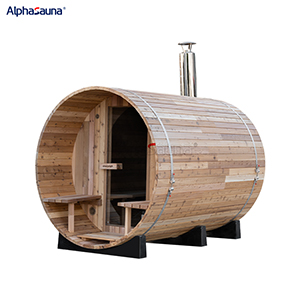In many people’s minds, saunas and sweating are inseparable. It’s often expected that even a few minutes in a sauna will result in profuse sweating. However, some individuals may find that they sweat less than expected or not at all after using the sauna. You might be wondering, “Why don’t they sweat in the sauna?” or “Is it problematic if I don’t sweat?” In fact, several factors can affect sweating in the sauna. This article will address these questions and provide answers to help you understand the issue better.


To understand the differences between traditional and infrared saunas and how they relate to sweating, let’s first explore each type.
Traditional Sauna
The traditional sauna originated in Finland and boasts a cultural history of thousands of years. Typically, this type of sauna heats stones with burning wood. In a traditional sauna, the temperature ranges from 70°C to 100°C, with humidity between 5% and 20%. Known for its high temperature and low humidity, the traditional sauna is one of the more primitive types of saunas. At these temperatures, traditional saunas promote significant sweating, which helps the body detoxify and relax muscles.
Infrared Sauna
With advancements in technology, infrared rays are now used in saunas as a form of heat therapy. Unlike traditional saunas, infrared saunas usually operate at temperatures between 50°C and 60°C, with humidity typically below 10%, creating a relatively dry environment. Instead of heating the air in the entire room, infrared saunas use infrared rays to penetrate the skin’s surface and directly heat the body’s internal tissues. This unique heating method is well-regarded for its health benefits, but due to the lower temperatures, it may not induce sweating as effectively as traditional saunas.

Reasons for Insufficient Sweating in Saunas
Sweating is often associated with the health benefits of saunas, but it is important to note that while sweating helps with detoxification, it is not essential for experiencing the many benefits of saunas.
In other words, if you find yourself not sweating in a sauna, it doesn’t mean you’re not receiving any benefits. For example, benefits such as relieving muscle pain, reducing inflammation, and improving blood circulation are all due to the effects of heat.
So, what are the effects of not sweating in a sauna? Here are some relevant factors to consider:
1. Dehydration
Sweat is primarily composed of water. If the body is dehydrated, sweat production will be limited. Without timely water replenishment, the high temperature in the sauna can impair bodily functions such as blood circulation, digestion, and temperature regulation. Dehydration can also reduce physical strength, affecting endurance and athletic performance.
2. Heat Resistance
Some individuals have a naturally high tolerance for heat and adapt better to high-temperature environments. As a result, they may sweat less or not at all compared to others.
3. Personal Physique and Genetic Factors
Everyone’s physiology is different. Some people have more active sweat glands and sweat more, while others have fewer sweat glands and sweat less. Additionally, rare genetic conditions like congenital anhidrosis can lead to defects or dysfunctions in sweat glands.
4. Different Types of Saunas
As previously mentioned, traditional and infrared saunas operate at different temperatures. Infrared saunas, while providing comfort and heat therapy, typically have lower temperatures and therefore may not induce sweating as effectively as traditional saunas.
Can You Get the Benefits of a Sauna Without Sweating?
Yes, you can still enjoy many benefits of a sauna even if you don’t sweat. The main function affected is the “sweat and detoxification function,” which helps expel toxins and waste from the body through the opening of pores. If you don’t sweat in a sauna, you may miss out on this particular benefit, but you can still gain the following advantages:
Blood Circulation: The sauna’s heat stimulates the body, dilates blood vessels, and improves blood flow. This enhances circulation throughout the body and increases oxygen supply to muscles and tissues, promoting faster recovery.
Relief from Muscle Tension and Soreness: The heat helps relax tense and stiff muscles, providing relief for those with muscle and joint pain.
Boosted Immune System: Even without sweating, the sauna’s temperature can still support the health of the immune system.
Stress Relief: The warm environment of the sauna is effective in alleviating physical, mental, and emotional stress. The tranquil atmosphere can provide psychological comfort and help reduce anxiety.
Improved Sleep Quality: The relaxation experienced after using the sauna can make it easier to fall asleep. Additionally, sauna use may promote melatonin production, which is beneficial for those who struggle with sleep or work irregular hours.
How to Address the Problem of Not Sweating
Regardless of the type of sauna you use, heat therapy can offer numerous benefits. If you are not sweating in the sauna, first consider whether the sauna may not be hot enough or if dehydration might be affecting your sweat production. If you find you are unable to sweat or sweat very little in a traditional sauna, you might want to consult a doctor or healthcare professional to understand the underlying issue and explore possible treatment options.





